‘Have a one-night-stand with a dress’ Guardian feature
If you picked up any of the weekend papers last week, you will notice that the topic of renting is everywhere once again. The Guardian wrote a feature called ‘Have a one-night-stand with a dress’: the fashion rental revolution, written by Jess Cartner-Morley.
Jess has been writing about Girl Meets Dress for the past 10 years so nothing new to the topic herself, and the sentence “Hiring clothes, until now limited to fancy dress and morning suits, is being rolled out on to the frontline of fashion. It is too early to know whether this will catch on…”¬†may not entirely be true… as it has ‘caught on’ all over the world a long time ago. The United Kingdom was in fact the first country to use this way of shopping since we launched in 2009. And Rent the Runway in the US the same year. In other countries, Australia, China and India, services followed and being used by millions of women all over the world every day.
…but with many brand new companies now launching here in the UK, the subject is inevitably once again being written about.
Read the article below:
“Instead of buying a new dress for each event, join the sustainable fashion movement and hire your outfit instead”
“Late in 1876, William Orton, then president of Western Union, received a proposal from Alexander Graham Bell. Bell offered to sell Orton the patent for his new invention, the telephone, for $100,000. Orton turned him down. ‚ÄúWhy,‚ÄĚ he scoffed, ‚Äúwould any person want to use this ungainly and impractical device when he can send a messenger to the telegraph office and have a clear written message sent to any large city in the United States?‚ÄĚ
Hmmm. My point is: things that you don‚Äôt think will catch on sometimes do. Keep that in mind, for a moment, while I tell you that this season‚Äôs most daring party dressing trend is not a hemline, nor a designer ‚Äď it is renting your dress, rather than buying it. Hiring clothes, until now limited to fancy dress and morning suits, is being rolled out on to the frontline of fashion. It is too early to know whether this will catch on, but it is an exciting possibility for anyone trying to square the circle of fashion and sustainability. And, well, stranger things have happened.
There are other logical ways to address fashion‚Äôs eco problem ‚Äď we could just keep wearing the clothes we already have, or invest in a capsule wardrobe of ethically produced pieces that will last ‚Äď but they require us to forsake fashion as fun. And fun is a crucial part of fashion. A rental model has the potential to include all the dopamine-hit elements ‚Äď the thrill of the new, the joy of getting dressed up ‚Äď while ditching the environmental wrecking ball of fast fashion. The cliche about millennials spending their incomes on brunch instead of houses may be just that, but it is true that our zeitgeist prizes experiences over belongings. And while we care as much as ever, if not more, about how we look at parties, weddings and even those salary-sapping brunches, the clothes we wear might well be rethought as an expense associated with an event, rather than an investment. Sequined dresses and dramatic LBDs are the most-wanted pieces on most rental sites. File alongside a blow dry, or ombre nail art, or your drinks bill, or taxi home.
The idea for¬†rental platform Girl Meets Dress¬†was born when former fashion PR Anna Bance realised that the practice of loaning designer dresses to celebrities to wear once for an event could be rolled out to civilians. Ten years on, Girl Meets Dress has a ‚Äúwardrobe in the cloud‚ÄĚ of more than 4,000 pieces to hire. ‚ÄúSometimes you want to take an Uber, sometimes you want to drive the car you own,‚ÄĚ says Bance. In the same way, she predicts ‚Äúhalf of women‚Äôs wardrobes are going to move into the cloud‚ÄĚ. Girl Meets Dress is simple to use: no need to subscribe, you can try on up to three dresses and only pay for the one you wear, and two-night dress hire costs between ¬£19 and ¬£119 depending on the retail value and popularity of the dress.
Just one month after launch, newbie¬†My Wardrobe HQ, which draws on clothes sitting unused in brand warehouses and the closets of fashion collectors, already has a 70% repeat user rate. My Wardrobe has put thought into the logistics: cleaning, which research found was a psychological barrier for would-be renters, is taken care of, using eco-friendly methods. Cofounder Tina Lake, former head of buying at Monsoon, ‚Äúwanted to right the wrongs that have been done in the fashion industry. I felt this could be the perfect time to make up for any damage done in my earlier career,‚ÄĚ she says. ‚ÄúWhen we came up with ‚Äėcashmere touch‚Äô knitwear we thought we were democratising fashion ‚Äď we didn‚Äôt realise that those millions of acrylic jumpers that sold for less than ¬£12 would end up in landfill, and be there for generations. With My Wardrobe, our aim is to extend the lifecycle of luxury items.‚ÄĚ
As a spokeswoman for¬†Extinction Rebellion¬†and the founder of fashion rental platform¬†Higher Studio, Sara Arnold is the poster girl for the crossover of clothes-for-hire and environmentalism. As well as putting a brake on shopping, ‚Äúa rental model incentivises design for longevity‚ÄĚ, she says. Higher Studio‚Äôs clothes skew alternative in their aesthetic ‚Äď think¬†Comme des Gar√ßons, Junya Watanabe,¬†Molly Goddard¬†and¬†Phoebe English. ‚ÄúWhat we hear most from customers is that we allow them to experiment and have fun with clothes in a way they hadn‚Äôt before,‚ÄĚ says Arnold.
For her university ball, recent fashion graduate Lotti Martin-Fuller spent ¬£20 on renting a dress worth ¬£100 from¬†Hirestreet, an accessibly priced platform renting mostly high street pieces. ‚ÄúI‚Äôve always felt guilty about consuming fast fashion,‚ÄĚ she says, ‚Äúbut also wanted to be up-to-date with trends. As a student, I didn‚Äôt have ¬£100 to splurge on a dress I might never wear again ‚Äď and I live in an Instagram generation where it‚Äôs almost a faux pas to be seen in a garment more than once. So this was a win-win.‚ÄĚ Hirestreet‚Äôs founder Isabella West reports that youthful clients are proud to tell people their dress is hired. She notices clients‚Äô shopping habits are evolving to fit a rental model ‚Äď by planning outfits well in advance in order to book dresses, for instance.
Hurr Collective¬†launched this year as ‚Äúthe Airbnb of fashion‚ÄĚ, says cofounder Tori Prew, with a peer-to-peer rental model. This calls for a more significant mindset adjustment. It feels more like paying a friend of a friend for the loan of a dress, than a rental version of online shopping. But there is a significant advantage, as I find when I browse the Hurr site and find a dress from cult label¬†The Vampire‚Äôs Wife¬†‚Äď a perfect minor-key party dress, in Liberty florals, with gold lurex trimmings ‚Äď in my size. It‚Äôs a doable ¬£114 to rent, in contrast to a prohibitive ¬£800 retail pricetag. What‚Äôs more, when I click on the dress I am taken to the page showing its owner‚Äôs other clothes ‚Äď including a Rixo sequined dress I‚Äôve often admired (¬£84 to rent, retail ¬£335). The sizes are subtly different across various labels in a way that precisely reflects my own experience of how big or small those labels come up, so it‚Äôs like stumbling across an edit preapproved by someone who matches my taste and body shape. Another early arriver on the peer-to-peer space is¬†By Rotation, an app aimed at generation Instagram which is a treasure trove for of-the-moment labels (you can hire a leopard-print¬†Ganni¬†party dress for ¬£9 a day) as well as designer staples (a classic quilted black leather, gold-strap Chanel handbag is ¬£50 a day).
Of course, once you‚Äôve sent it back you have nothing to show for your money. The maths takes some adjusting to if a bulging sack of Zara loot is your benchmark of value for money ‚Äď although it is worth reminding yourself how infrequently those last-minute party buys turn out to be great long-term investments, and becoming a lender upturns the financial odds in your favour. Tania-Claudia Berresford, who rents out clothes on Hurr, says one of her dresses ‚Äúhas more than paid for itself‚ÄĚ in fees already. By Rotation claims you can make money back on an item worth ¬£100 in between three and five rentals, depending on the listing price you choose.
Right now, renting is a victim of its own success. Demand outstrips supply, and Hurr currently has a waiting list of 10,000 ‚Äď although you may be able to skip the queue if you can get a referral from an existing member. Even then, you are likely to have a better user experience if you are a size 10 and London-based, than if you are a size 18 and live outside a major city. What‚Äôs more, detractors point to the environmental impact of the miles travelled by clothing zigzagging between wearers. To combat this, Hurr Collective items can be delivered ‚Äď within London ‚Äď using the¬†green cycle courier service Pedals; Higher Studio has a subscription model that steers users towards keeping pieces for longer, rather than exchanging them after one outing.
Event dressing for parties and weddings is just the test case for rental. Already up and running is¬†Cocoon, a ‚Äúmembers‚Äô club for handbag lovers‚ÄĚ. For ¬£99 a month, you can hire one handbag at a time, keeping it as long as you want, or swapping as soon as you want. Stock includes the¬†Bottega Veneta new-season squishy intrecciato leather handbag¬†that the entire fashion industry is lusting over, as well as modern classics like the¬†Loewe puzzle bag¬†and timeless icons from Saint Laurent. The next frontier will be brands launching their own rental channels, a development that My Wardrobe‚Äôs Tina Lake describes as ‚Äúinevitable. Retail pundits are predicting that by 2025 20% of contemporary and luxury revenue will be from rental.‚ÄĚ The new collection from¬†hot London label Farleigh.io¬†will be the first by an emerging British designer to be available on a direct-to-consumer rental model. The more expensive, event-orientated pieces ‚Äď think 70s-style ruffled party dresses in inky velvets ‚Äď will be available both as click-to-rent for four-day periods, and as click-to-buy.
For now, renting a dress still feels adventurous; even ‚Äď when the dress arrives still-warm from someone else‚Äôs wardrobe ‚Äď daringly intimate. But it‚Äôs party season, after all. The time for brief encounters, for living in the moment, with no commitment and no baggage. Have a one-night-stand with a dress. The planet will love you for it.”


 Designer A-Z
Designer A-Z 








